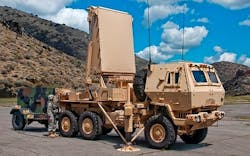Lockheed Martin to upgrade TPQ-53 radar microelectronics to improve accuracy in high clutter
McCLELLAN PARK, Calif., 12 July 2016. Military microelectronics experts at Lockheed Martin Corp. are upgrading electronic components in the AN/TPQ-53 fire-control radar to improve the system's abilities to track and locate hostile rocket, artillery, and mortar fires in high-clutter environments.
Officials of the U.S. Defense Microelectronics Activity (DMEA) in McClellan Park, Calif., announced their intention Monday to award a $4.1 million contract to the Lockheed Martin Mission Systems and Training segment in Syracuse, N.Y., to make the AN/TPQ-53 upgrades.
The so-called Q-53 is a solid-state phased array radar that detects, classifies, tracks, and determines the location of enemy indirect fire weapons like rockets, artillery shells, mortars, and even unmanned aerial vehicles (UAVs) in either 360- or 90-degree modes. This system is replacing the aging U.S. Army AN/TPQ-36 and AN/TPQ-37 medium-range radars.
DMEA officials say they plan to award a $4.1 million contract to Lockheed Martin to upgrade the Q-53 radar's capabilities to increase its accuracy amid high radar clutter, decrease its false location rate, as well as improve its probability of location and probability of correct classification.
Lockheed Martin originally won a $7.1 million DMEA contract in March 2015 for Q-53 radar system product improvements, including increasing its radar range, radar accuracy point of origin, radar accuracy, and point of impact.
The overall goal is to improve the TPQ-53 radar capabilities to increase its counter fire radar flexibilities. Lockheed Martin started developing the Q-53 counter-fire radar in 2007.
The AN/TPQ-53 radar is the U.S. Army's standard forward-deployed system for long-range surveillance and tracking radar against rockets, artillery, and mortar threats for brigade combat teams. Lockheed Martin is correcting system anomalies detected during testing and during live operations.
The Q-53 radar is deployed on an Army 5-ton FMTV truck, and can go into battle with heavy, medium, and light forces. A second tactical truck carries an operations control shelter, backup power generator, and two additional soldiers to operate the system.
Last month Lockheed Martin announced Q-53 radar software upgrades that demonstrated the system's ability to identify and track UAVs and pass that information to a command and control node.
"The inherent flexibility of the Q-53’s active electronically scanned array (AESA) hardware architecture allows us to constantly evolve the Q-53’s software to deal with emerging threats," says Rick Herodes, Lockheed Martin's Q-53 program director.
Demonstrations at the Army Maneuver and Fires Integration Experiment (MFIX) at Fort Sill, Okla., showed the Q-53 can adapt to provide air surveillance and counter fire target acquisition in one tactical sensor.
Lockheed Martin officials say they expect th Army to award a full-rate production contract for the Q-53 this year. The company builds the Q-53 radars in Syracuse and Owego, N.Y.; Moorestown, N.J.; and Clearwater, Fla.
For more information contact Lockheed Martin Mission Systems and Training online at www.lockheedmartin.com/us/mst, or the Defense Microelectronics Activity at www.dmea.osd.mil.

